| Lepistella | |
|---|---|
| Scientific classification | |
| Kingdom: | |
| Division: | |
| Class: | |
| Order: | |
| Family: | |
| Genus: | Lepistella T.J.Baroni & Ovrebo |
| Type species | |
| Lepistella ocula T.J.Baroni & Ovrebo | |
Lepistella is a genus of fungus in the family Tricholomataceae. It is a monotypic genus, containing the single species Lepistella ocula, found in Central America and reported as new to science in 2007. [1]

Rolf Singer was a German-born mycologist and one of the most important taxonomists of gilled mushrooms (agarics) in the 20th century.

The spore print is the powdery deposit obtained by allowing spores of a fungal fruit body to fall onto a surface underneath. It is an important diagnostic character in most handbooks for identifying mushrooms. It shows the colour of the mushroom spores if viewed en masse.

The Tricholomataceae are a large family of mushrooms within the Agaricales. Originally a classic "wastebasket taxon", the family included any white-, yellow-, or pink-spored genera in the Agaricales not already classified as belonging to e.g. the Amanitaceae, Lepiotaceae, Hygrophoraceae, Pluteaceae, or Entolomataceae.
Cantharellopsis is a tan- to whitish-colored bryophilous monotypic genus in the Hymenochaetales. The fruit bodies of the single species Cantharellopsis prescotii has a form intermediate between an Omphalina and a chanterelle (Cantharellus) because of its forked, fold-like gills. It inhabits moss on calcareous soils in temperate regions of Europe. Phylogenetically related agarics are in the genera Contumyces, Gyroflexus, Loreleia, Rickenella and Blasiphalia, as well as the stipitate-stereoid genera Muscinupta and Cotylidia and the clavarioid genus, Alloclavaria.
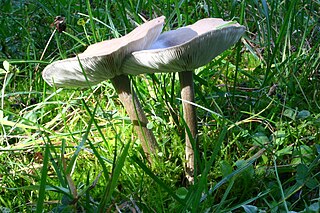
Melanoleuca is a poorly known genus of saprotrophic mushrooms traditionally classified in the family Tricholomataceae. Most are small to medium sized, white, brown, ocher or gray with a cylindrical to subcylindrical stipe and white to pale yellowish gills. The basidiospores are ellipsoid and ornamented with amyloid warts. Melanoleuca is considered a difficult group to study due to their macroscopic similarities among species and the need of a thorough microscopic analysis to separate species. DNA studies have determined that this genus is closely related to Amanita and Pluteus and that it does not belong to the family Tricholomataceae.

Collybia is a genus of mushrooms in the family Tricholomataceae. The genus has a widespread but rare distribution in northern temperate areas, and contains three species that grow on the decomposing remains of other mushrooms.
Arthrosporella is a fungal genus in the family Tricholomataceae. It is a monotypic genus, containing the single species Arthrosporella ditopa, found in South America. The genus was described by mycologist Rolf Singer in 1970.
Cynema is a genus of fungi in the family Tricholomataceae. This is a monotypic genus, containing the single species Cynema alutacea, found in Papua New Guinea.
Cyphellocalathus is a genus of fungi in the family Tricholomataceae. This is a monotypic genus, containing the single species Cyphellocalathus cecropiae, found in Bolivia.
Dennisiomyces is a genus of fungi in the family Tricholomataceae. Described by mycologist Rolf Singer in 1955, the genus contains five species found in South America.
Stanglomyces is a genus of fungi in the family Tricholomataceae. This is a monotypic genus, containing the single species Stanglomyces taxophilus, found in South America. The species was described as new to science by Jörg Raithelhuber in 1985.
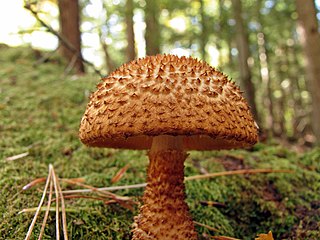
Leucopholiota decorosa is a species of fungus in the mushroom family Tricholomataceae. Commonly known as the decorated pholiota, it is distinguished by its fruit body which is covered with pointed brown, curved scales on the cap and stem, and by its white gills. Found in the eastern United States, France, and Pakistan, it is saprobic, growing on the decaying wood of hardwood trees. L. decorosa was first described by American mycologist Charles Horton Peck as Agaricus decorosus in 1873, and the species has been transferred to several genera in its history, including Tricholoma, Tricholomopsis, Armillaria, and Floccularia. Three American mycologists considered the species unique enough to warrant its own genus, and transferred it into the new genus Leucopholiota in a 1996 publication. Lookalike species with similar colors and scaly fruit bodies include Pholiota squarrosoides, Phaeomarasmius erinaceellus, and Leucopholiota lignicola. L. decorosa is considered an edible mushroom.
Catatrama is a fungal genus in the family Amanitaceae, order Agaricales. Originally a monotypic genus with Catatrama costaricensis, found in Quercus pilarius forest in Costa Rica. In 2007, the species was reported from Brazil. Since then 2 additional species, one from Australia and one from India have been recognized.
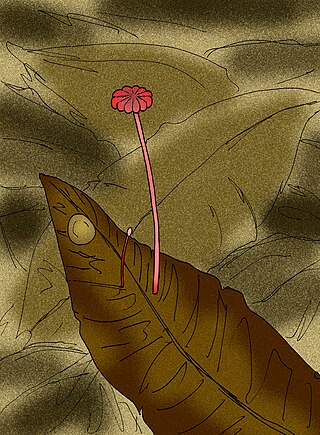
Archaeomarasmius is an extinct genus of gilled fungus in the Agaricales family Tricholomataceae, containing the single species Archaeomarasmius leggetti. It is known from two fruit bodies recovered from amber, one consisting of a complete cap with a broken stem, the other consisting of a fragment of a cap. The cap has a diameter ranging from 3.2 to 6 mm, while the stem is 0.5 mm (0.02 in) thick. Spores were also recovered from the amber, and are broadly ellipsoid to egg-shaped, measuring roughly 7.3 by 4.7 μm. The species, which resembles the extant genera Marasmius and Marasmiellus, is inferred to have been saprobic on plant litter or other forest debris.
Aureofungus is an extinct monotypic genus of gilled fungus in the order Agaricales. At present it contains the single species Aureofungus yaniguaensis.

Nothoclavulina is a genus of fungus in the family Tricholomataceae. The genus is monotypic, containing the single species Nothoclavulina ditopa, described by American mycologist Rolf Singer in 1970. The species, found in Argentina, is an anamorphic version of the genus Arthrosporella. The generic name Nothoclavulina is Latin for "false Clavulina".
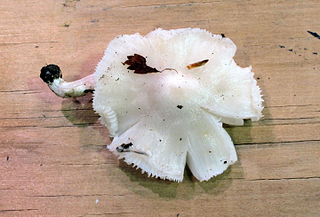
Albomagister is a genus of fungi in the family Tricholomataceae. The genus contains just one named species known from Tennessee and North Carolina, however two other undescribed species have been sequenced. Albomagister was described by mycologists Marisol Sánchez-García, Joshua Birkebak & P. Brandon Matheny in 2014 with Albomagister subaustralis as the type species.
Corneriella is a genus of fungi in the family Tricholomataceae. The genus contains two species known from the United States and Thailand, and at least four others have been detected by DNA sequencing. Corneriella was described the mycologist Marisol Sánchez-García in 2014 with Corneriella bambusarum as the type species.
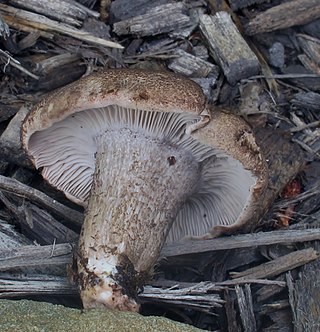
Pseudotricholoma is a genus of fungi in the family Tricholomataceae. The genus contains three species known from North America. Europe, and the Azores. Basidiocarps resemble those of the genus Tricholoma, with a dry fibrillose pileus and white to brown lamellae that have adnate to emarginate attachment and stain reddish when damaged, eventually turning black. Microscopically, the basidiospores are smooth, ellipsoid to ellipsoid-oblong, thin-walled and amyloid. Cheilocystidia are rare to absent and pleurocystidia are absent. The pileipellis is a cutis and clamp connections are present. Species in Pseudotricholoma are found on soil in grasslands and woods. They are probably biotrophic, and may be ectomycorrhizal.